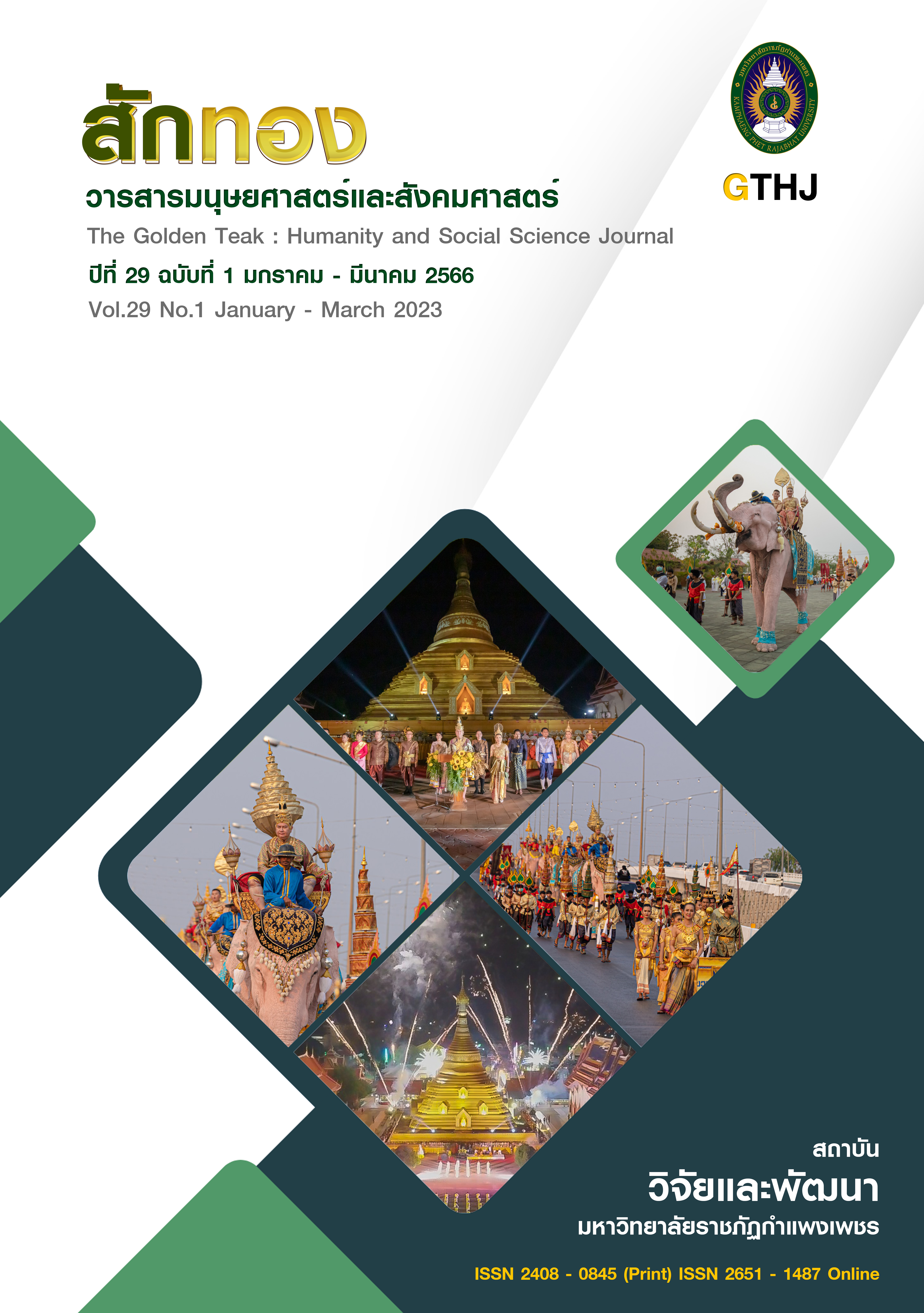ปัจจัยที่มีอิทธิพลต่อการเลือกใช้บริการธนาคารอิเล็กทรอนิกส์ในจังหวัดระยองตามแบบจำลองไอด้า
Main Article Content
บทคัดย่อ
ธุรกิจธนาคารอิเล็กทรอนิกส์มีการเติบโตขึ้นอย่างมากตามปริมาณการใช้งานเครือข่ายอินเทอร์เน็ตที่เพิ่มขึ้นทุกปี การวิจัยครั้งนี้มีวัตถุประสงค์เพื่อวิเคราะห์องค์ประกอบเชิงยืนยัน และตรวจสอบความสอดคล้องระหว่างโครงสร้างเชิงองค์ประกอบของปัจจัยที่มีอิทธิพลต่อการเลือกใช้บริการธนาคารอิเล็กทรอนิกส์ในจังหวัดระยองตามแบบจำลองไอด้ากับข้อมูลเชิงประจักษ์ กลุ่มตัวอย่างเป็นประชากรในจังหวัดระยอง จำนวน 400 คน เครื่องมือที่ใช้ในการวิจัยครั้งนี้ ได้แก่ แบบสอบถาม ค่าความเชื่อมั่นของแบบสอบถามทั้งฉบับเท่ากับ 0.95 สถิติ
ที่ใช้ประกอบด้วยการวิเคราะห์องค์ประกอบเชิงสำรวจ การวิเคราะห์องค์ประกอบเชิงยืนยัน และการวิเคราะห์องค์ประกอบเชิงยืนยันอันดับสอง ผลการวิจัยพบว่า ปัจจัยที่มีอิทธิพลต่อการเลือกใช้บริการธนาคาอิเล็กทรอนิกส์ในจังหวัดระยองตามแบบจำลองไอด้า ประกอบด้วย 4 องค์ประกอบ โดยองค์ประกอบที่มีค่าน้ำหนักเรียงจากมากไปหาน้อย ได้แก่ ความปรารถนา (Desire) การตัดสินใจ (Action) กระตุ้นความสนใจ (Attention) และ ความสนใจ (Interest) ผลการวิเคราะห์องค์ประกอบเชิงยืนยันอันดับแรก พบค่าดัชนีทุกตัวผ่านตามเกณฑ์
มีน้ำหนักองค์ประกอบ 0.59-0.80 มีนัยสำคัญทางสถิติที่ .01 และผลการวิเคราะห์องค์ประกอบเชิงยืนยันอันดับสอง พบค่าดัชนีทุกตัวผ่านตามเกณฑ์ มีน้ำหนักองค์ประกอบ 0.77-1.02 มีนัยสำคัญทางสถิติที่ .01 ผลการวิจัยนี้จะทำให้ทราบแนวทางในการศึกษาปัจจัยที่มีอิทธิพลต่อการเลือกใช้บริการธนาคารอิเล็กทรอนิกส์ เพื่อให้ธนาคารผู้ให้บริการธนาคารอิเล็กทรอนิกส์ สามารถนำผลการวิจัยไปพัฒนาระบบให้ตอบสนองความต้องการของผู้ใช้ได้มากขึ้นต่อไป
Article Details

อนุญาตภายใต้เงื่อนไข Creative Commons Attribution-NonCommercial-NoDerivatives 4.0 International License.
บทความที่ได้รับการตีพิมพ์เป็นลิขสิทธิ์ของวารสาร สักทอง : วารสารมนุษยศาสตร์และสังคมศาสตร์ สถาบันวิจัยและพัฒนา มหาวิทยาลับราชภัฏกำแพงเพชร
ข้อคิดเห็นใดๆ ที่ปรากฎในวารสารเป็นวรรณกรรมของผู้เขียนโดยเฉพาะ ซึ่งมหาวิทยาลัยราชภัฏกำแพงเพชรและบรรณาธิการไม่จำเป็นต้องเห็นด้วย
เอกสารอ้างอิง
Abdelkader, O.A. & Rabie, M.H. (2019). Exploring The General Awareness of Young Users According to AIDA Model Applied to Social Networking Ads. Journal of Theoretical and Applied Information Technology, 97(6), 1693-1703.
Angsuchot, S., Wichitwanna, S. & Phinyophanuwat, R. (2011). Statistical analysis for research in socialsciences and behavioral science : Techniques in using LISREL program. Bangkok : Charoendi Mankhong Press. [In Thai]
Arbuckle, J.L. (2013). IBM SPSS Amos 22 User’s Guide. U.S.A. IBM Corporation.
Baabdullah, A.M., Alalwan, A.A., Rana, N.P., Kizgin, H. & Patil, P. (2019). Consumer use of mobile banking (M-Banking) in Saudi Arabia: Towards an integrated model. International Journal of Information Management, 44, 38-52.
Chandra, W. & Wirapraja, A. (2020). The Effect of Application Usability, Service Quality, and E-Satisfaction on Purchase Intention of GoFood Customers. Indonesian Journal of Information Systems, 3(1), 38-49.
Danaei, A. & Sanei, N. S. (2019). The effect of health-related messages on the behavior of social network audiences according to attention, interest, desire, action model. Journal of Research and Health, 9(6), 525-532.
Department of Industrial Works. (2020). Industrial statistics. [Online]. Available : https://www.diw.go.th/hawk/content.php?mode=spss63 [2021, February 2].
Joshi, A., Kale, S., Chandel, S. & Pal, D.K. (2015). Likert scale: Explored and explained. British Journal of Applied Science & Technology, 7(4), 396.
Kayumovich, K.O. (2019). The capability of internet in sphere of tourism and services. Polish science journal, 5(14), 160-164.
National Broadcasting and Telecommunications Commission. (2020). Report of the results of an Internet survey in Thailand. [Online]. Available : http://webstats.nbtc.go.th/ netnbtc/INTERNETUSERS.php [2021, September 2].
National Statistical Office. (2020). Demographic statistics population and housing. [Online]. Available : http://statbbi.nso.go.th/staticreport/page/sector/th/01.aspx [2021, September 3].
Prathapan, M., Sajin Sahadevan, D. & Zakkariya, K.A. (2018). Effectiveness of digital marketing: Tourism websites comparative analytics based on AIDA model. International Journal of Innovative Research & Studies, 8(4), 262-273.
Rehman, F.U., Nawaz, T., Ilyas, M. & Hyder, S. (2014). A comparative analysis of mobile and email marketing using AIDA model. Journal of Basic and Applied Scientific Research, 4(6), 38-49.
Sanayei, A., Shahin, A. & Amirosadt, S. N. (2013). Evaluating the effectiveness of TV advertisement and analyzing its influence on attraction of saving deposit accounts of Ansar Bank in the city of Isfahan. Journal of Business Administration and Management Sciences Research, 2(2), 53-58.
Tan, W.K., Hsiao, Y.J., Tseng, S.F. & Chan, C.L. (2018). Smartphone application personality and its relationship to personalities of smartphone users and social capital accrued through use of smartphone social applications. Telematics and Informatics, 35(1), 255-266.
Winkowska, J., Szpilko, D. & Pejić, S. (2019). Smart city concept in the light of the literature review. Engineering Management in Production and Services, 11(2), 70-86.
Yamane, Taro. (1967). Statistics, An Introductory Analysis. (2 nd ed). New York : Harper and Row.


